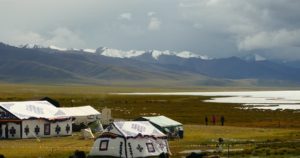In a pasture at 16,000 feet high, surrounded by the Himalayan peaks, Bank’s stopped for a picnic on the road to Lhasa. The campsite is chosen not by hunger but by availability. It was level enough for a camp. Their motorcar is unpacked, a fire lighted, and tea is started. It’s a glorious moment, and Banks writes, “And so we sit, nine human beings in a circle, encircled by a wall of mountains that swallow up our laughter and tiny voices.” Then amidst the thrill, the leader Dawa whacks off the whole top of the leg of mutton, an action of such ferocity that Banks suggests it’s “decidedly Neanderthal.”

Tibetans picnic at the top of the world; they can’t help it. Though they may dine on the grass, traditional picnics are often held in gaily-colored tents of golds, blues, and reds.
The contrast of place, food, and sensibilities makes this a memorable picnic for Westerners but not for the Tibetans. The menu includes a roasted leg of mutton, red pepper, salt, churned black tea (sö cha), yak butter, and roasted barley bread (tsampa). There are no forks, plates, or other amenities; slices of lamb (dried but not cooked) were cut and placed on the ground, grass, or rocks. This was accompanied by roasted barley flour dough mixed with yak butter tea and eaten raw.
Other Tibetan picnics are more gentle and picnicky than the one painted by Thakchoe, a teenager living in exile in India. His picnic recalls the happy dream of his homeland. Children play while adults sit on picnic cloths, drinking tea and gambling, a national pastime.
Featured Image: Thakchoe. Picnic (1998), tempera on paper. Private Collection.
See Barbara Banks. “A Tibetan Picnic.” (1996) In The Gift of Travel, Inspiring Stories from Around the World, edited by James O’Reilly, Larry Habegger, and Sean O’Reilly. San Francisco, CA, 2004; Museum of International Folk Art. The Art of Exile: Paintings by Tibetan Children in India. Santa Fe, New Mexico: Museum of New Mexico, 1998.

